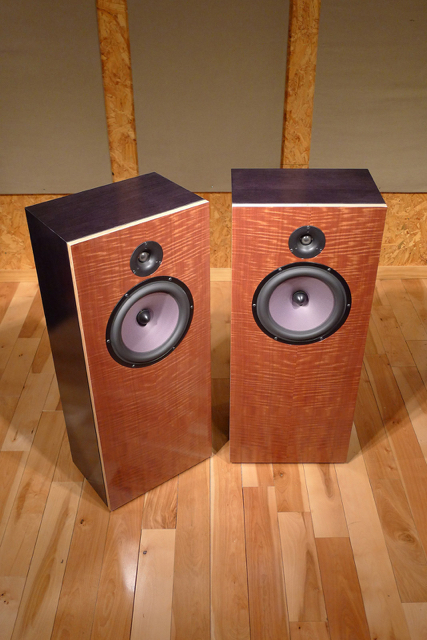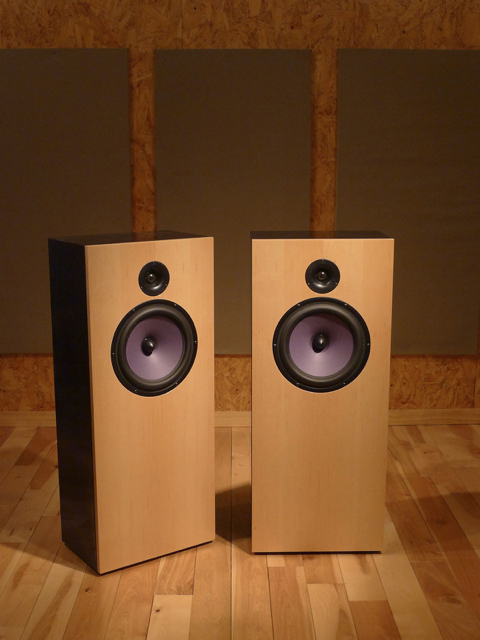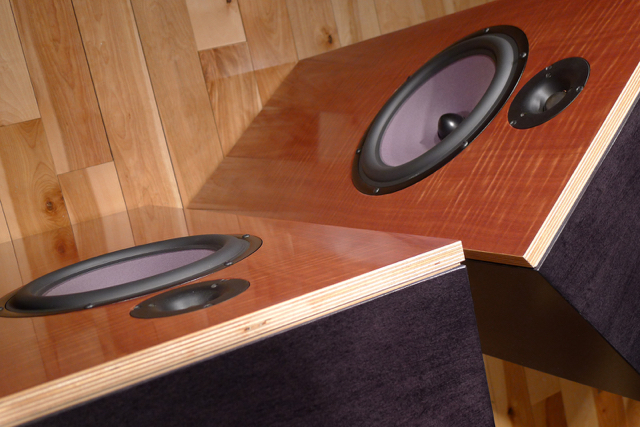In the spring of 2014, I reviewed the DeVore Fidelity Orangutan O/96 speakers. In the conclusion of that review, I shared a quote from another reviewer who had come over to listen to them. He turned to me and said, “These speakers are just good for the heart!” I agree. The DeVore Fidelity Orangutan O/96 speakers play music in a way that is incessantly and persistently emotionally moving! So now three years later, I’ve taken a few weeks to listen to the DeVore Orangutan O/93s.

Even though both the O/93s and the O/96s use similar drivers and both have fine furniture finished cabinets, there are some significant differences. The most obvious is in the name, the O/93 is 3dB less efficient than it’s big brother. This means that while you can still drive the O/93s with an eight or ten-watt SET, unless you listen at low volume levels, you probably can’t use tiny SET amps. Another difference is that the bigger O/96s are stand-mounted and the O/93 is floor standing. One more difference I’ll mention is that while they both use the same 10-inch paper cone for the woofer, the O/96 uses a more powerful motor, and more expensive crossovers and cabinets.
?Readers who enjoyed this review might also want to see the review of the DeVore gibbon Super Nines here.
Let me share a little of what I said about the Orangutan O/96 speakers in Part 1 of my review for Dagogo. “John DeVore has done an amazing job with the two Orangutan speakers of making a modern speaker that has many of the virtues of vintage speakers. Most of the high-end audio industry, especially the mainstream companies are dominated by products that seem to be chasing the latest technologies. This not only applies to things like digital and Class D amps, but even in the world of tube amplification, analog playback systems, and speakers. We see speakers being made whose cabinets are made of space-age composites and drivers made of ceramic, diamonds, kevlar, and many other modern high tech materials.
With all this new and greatest technology there is still a devoted group of audiophiles and music lovers that still use SET amps that go back in design to the 30s. They listen to music on turntables and even listen to lots of mono recordings. There are even a good number of audiophiles who are returning to vintage products looking for a more emotionally involving sound. The good news for that group is that John DeVore has good friends who are part of that group and decided to make a modern speaker that meets those needs. As far as I’m concerned he has achieved more than could have been expected in the two Orangutan speakers.”
Appearance
Standing only 35.5 inches high by 15 inches wide and only 10 inches deep, the O/93s don’t take up that much space in my room. There are two smallish parallel ports that adorn the speakers’ lower and well-finished backs. Instead of spikes, there are four wooden feet that are so small the speaker looks like it’s sitting directly on the floor. The O/93s most often come in a fiddleback mahogany veneer that covers several layers of Baltic birch plywood. My review pair was in a custom maple finish. The veneers of the left and right speakers are mirror images of each other. The sides, backs, and tops are veneered in maple and finished in a high-gloss, piano-black lacquer. I wish more speakers cabinets were this much like high-end furniture. I see speakers all the time that sell for five and six figures that won’t fit into your home with anywhere near the beauty of the DeVore speakers. Personally, I especially like the looks of the two Orangutan speakers.

Setup
I unpacked the speakers, and I want to let you know, John DeVore really knows how to pack a speaker for safe shipping. I began by setting them in the same spot where my Teresonic Ingenium speakers sit. I knew this pair of O/93s had over 100 hours on them, but I still let them play for a day or two before sitting down to really listen to them. They sounded really nice after two days, so it was time to begin to work on placement. I should mention that as good as they sounded when first unpacked they really came into all their glory after a couple of hundred more hours of playing time.
When I finally found the place where they sounded their very best, it was wider apart than most speakers in my room. They were eight feet apart measured from tweeter to tweeter. I have over the years found where my listening chair should be for best bass response, which is about six feet from the wall behind it. So, the next thing to do was to find out how far from the listening chair they sounded best. This ended up being ten and a half feet, with them toed in such that they were aimed just outside my shoulders. In this position, the center of the front panel was 45 inches from the wall behind the speakers and 27 inches from the side walls. I should mention that their distance from each other had more effect on the quality of the bass than the distance from the wall behind the speakers. This is probably the most overlooked part of speaker placement. For some reason, we always think first about the distance from the rear and side walls.
Distance from the wall behind the speakers is important too. I found it easy to tune the speakers by moving them back and forth by a few inches. If I moved them too far out, the midrange was too thin and the bass was a little light, but when I got them just right the sound locked in. They sound very good if you get them close to the right spot, but if you just work a little they will reward you with some beautiful music.

The Review System
The review system I used for this review consisted of the AMG V12 table and their turbo tonearm sitting on the HRS stand made for the AMG table. The cartridge was the DS Audio Master1 cartridge and the DS 1 phono preamp. Standing in for a line stage is Emia’s Remote Autoformer and the XA30.8 amplifier. All the equipment was set on a doublewide Box Furniture rack, and everything was plugged into the HB Cables PowerSlave Marble. The power cords were High Fidelity Cables CT-1 Ultimate Reference Rhodium Plus. All of the interconnects and speaker cables were High Fidelity Cables CT-1 Ultimate Reference.
Listening
As I listened to the O/93s, one thing that came to my mind about the sound of these speakers is that you can’t listen to them without coming away thinking, “Man, that sounded beautiful.” I know my job is to tell you what the O/93s sound like, but let me start by saying that this is a speaker that doesn’t sound like it looks. They are small, two-way, floor standing speakers; but they sound like BIG floor standing speakers. So, if I had to put it very succinctly, I’d say the O/93s sound big and alive like live music sounds.
They have the ability to transport you to a live performance in a way that few other speakers have in my room. The music is energizing, life-size, and powerfully moving, in a way that is more similar to how live music draws you in than most other speakers. They consistently brought me close to a live performance. Not my Teresonics, but most speakers that I review sound tame by comparison.
Few other speakers that I have heard in any setting are as great at reproducing a jazz drum kit or brass instruments as the O/93s. As I have said before, it’s so hard to know if your system is accurate when playing drums. I will never forget one night at the Pops when, during intermission, they changed the setup on the stage for the guest who was coming up. This included a new drummer and drum kit. The difference these changes made was between what we audiophiles would call slow, overdone bass with the first set and fast, tight bass with the second set. Now, I ask you, how would you know this if you weren’t there? Yet, there is something I can tell you about both drum sets and drummers. They both carried the rhythm and pace of the music. So, I think that’s what we always have to judge the ability of a system by when it comes to drums. It’s easy to rob all the weight and substance from your system if you try to get every recording to have fast and tight bass, but I feel drums should always convey real rhythm and pace.
Maybe I’m the only one, but it has always amazed me at the symphony when the percussionist would strike the little triangle and you could so clearly hear it above all of the other instruments. Truth is, the more easily you can hear these little percussion instruments, the more natural the music sounds. The O/93s do this in a wonderful way that seems to be in perfect balance. Like everything I’ve heard over these speakers, you don’t just get the sound of the percussions, you also get a wonderful sense of their harmonic structure.
Then, there are the cymbals. They can range in sound from a startling crash to a very brassy bright sound and a very silvery shimmer. All cymbals do not sound alike, just like drums don’t, but speakers that play cymbals right will let you hear those differences with ease and naturalness. I thought these speakers played cymbals in a very natural and revealing way.
Since I mentioned the brass, I should add that the woodwinds sounded exceptional on the O/93s. One of the things I noticed was that for both brass instruments and woodwinds, the treble was sweet, extended and never edgy or etched. I confess I love woodwinds. I own most of Pete Fountain’s records; he played a great clarinet. I love to hear the great jazz saxophone players. On the classical side, flutes and oboes really appeal to me. To reproduce woodwinds your speakers have to have a great balance from the upper bass through the top-end. These instruments move small amounts of air, but this air is a very essential part of their sound. If your system doesn’t let you hear these nuances, then the music will sound nice, but not alive.
Horns are more demanding than woodwinds in both frequency range and dynamics. Most speakers find it difficult to get the explosive dynamics, the bite, and the body of a trumpet right without sounding edgy, bright, or overly muted. The O/93s are amazing with horns. These attributes mean they are great on big band music. It comes to life without hurting your ears or damping out the power of the band.
Another instrument that was reproduced beautifully was the piano. Whether it was Bill Evans, Oscar Peterson or Monk, the sound was alive, full-range, and the performance came through with great emotion. It’s one thing for a solo piano to sound realistic, but with the O/93s in my system pianos had weight and a sense of aliveness when played in a jazz ensemble or a symphony orchestra.
Bowed strings are a big test for any speaker. The O/93s played bowed strings with the sweetness and air of real-life and with the fullness and richness I have become accustomed to hearing from a speaker like the big Tannoys. One of my favorite recordings is King of the Cellist, Starker plays Kodaly. This is the most powerful recordings of a cello I have heard. I find Starker’s playing to come across as quite intense, but full of feelings. The O/93s played this album better than any speaker I have heard except for its big brother the O/96s.
Violins and violas sounded just as good as the cello. The sound was sweet, at times downright liquid, but never bright or strident. The emotions relayed as the bow is slowly pulled across the strings were very involving. You could hear the different layers and textures of the tones of the strings as you heard the bow pass over each of them. Massed strings were very visceral, full-bodied and extended while never being abrasive. The strings were both powerful and relaxed. It is simply amazing the powerful sound the string bass section of an orchestra can have when played through the O/93s.
The most important thing for a system to get right to me is the human voice. For me, a system must play vocals so that they sound natural and alive and allow you to sense the space and context of where the voice has been recorded. My Teresonic Ingenium XRs do this as well, if not better, than any speaker I have heard at any price. The O/93s come really close, and they were very satisfying on voices. They play voices with natural space around them. Voices seem to just appear out of a very solid space as well as being full and smooth. I also liked that they play voices so that they are more a part of the whole than being spotlighted and separated from the rest of the music. The O/93s let me hear beautiful, full tonal color in the voices. One of the things that allows so much music to sound so realistic is how dynamic the O/93s are, how lively they sound and they are better than most micro-dynamics.
In my listening room, the O/93s created a deep, wide soundstage with a nicely focused center. I’ll admit that some modern speakers have more soundstage depth and image specificity, but few portray a more realistic stage of music. The only area that I think could be improved may be image height, but it’s not a big deal. The way this speaker plays mono recordings, and the space of instrument within the small stage of mono, was exceptional.
Now let’s move on to talk about some specific LPs and how they sounded played through the DeVore O/93s.
Rob Wasserman’s Duets
I carry this recording all around at audio shows using it to evaluate systems. Very few of the systems at any price can hold it all together when they play the cut “Angel Eyes.” On this cut, Cheryl Bentyne’s voice goes from very soft to very loud, then back down to almost a whisper, and then explodes to end the cut. It is a real test of a system’s dynamics, harmonics, and ability to sound as good when played very softly as very loudly. Over the O/93s Bentyne’s voice went from very low volume to extremely loud and never broke up. Wasserman’s bass sounded visceral and quick.
Joni Mitchell’s Blue
In 1971, I was a 17-year-old freshman at Baylor University. It there that I discovered Joni Mitchell and the album Blue was my first exposure to her beautiful voice and intriguing music. Well it’s 46 years later, and I’m a bit older, but I still love this album. Truth is I probably enjoy it more now than I did when I was young and listened to it on KLH 17s, on Double Advents, and then on Quad 57s for years. In the last few years, it has been on my Teresonic Ingenium XR Silvers. I know this LP inside and out, and I’ve never been any more emotionally moved by it in all these years as I was listening to it over the O/93s. Mitchell’s voice was right there in the room, juicy and full of different tonal colors. The piano sounded good, and the guitar sounded as good as I’ve ever heard. Overall, the O/93s brought the emotion of this album to life in my room in a really moving way.
The Weavers Reunion At Carnegie Hall, 1963 and Belafonte Live at Carnegie Hall
Speaking of LPs that I have listened to for many years, these are two recordings that, thanks to Harry Pearson, almost every audiophile from the early days of The Absolute Sound had to own. The Weaver’s recording was done very simply. It was recorded on three tracks with an Ampex 300 at 15 1/2 IPS. All three mics were Schoeps M-221B/26 condensers.
Both of these recordings can show the best and the worst of the way some audiophiles listen to music. So, let me say, I’m not interested in hearing tape splices, how many feet one singer is from the other or other such non-musical artifacts. These are two albums that should be really fun to listen to; they should show musical artistry that is seldom heard from folk groups or pop singers. The listening experience of these two albums should definitely be from the perspective of you are there and not they are in the room with you. The O/93s lets you feel as if you are in the hall and let you experience the joy of the performers. With both albums at the end, I feel like I have been to an incredible live musical event. What more could one ask for from their speakers?
Sauerkraut and Solar Energy
This Flying Fish album with Norman Blake, Tut Taylor, Sam Bush, Butch Robbins, Vassar Clements, David Holland, and Jethro Burns is DAWG music at its best. On many modern speakers, this album is all about the leading edge and speed. There should be more to this recording. Played over the O/93s there was the richness and real sweetness with the strings. It portrayed the instruments nicely on the stage with air and space around and within the instruments. This recording should be loads of fun, and it was on the O/93s.
Gershwin Rhapsody In Blue & An American In Paris
Back when I was in high school, this was one of my first ventures into what I then thought of as classical music. I have enjoyed this recording for over 40 years now. Over the O/93s the recording sounds more alive and more like you are in the hall than with most multi-miked recordings we have now. Gershwin’s music requires a system with great PRaT (pace, rhythm, and timing), and the O/93s have PRaT in spades.
Speaking of PRaT, it’s unusual for a speaker with real richness and such weight to have exceptional PRaT. The O/93s have all of these. I can’t tell you what a toe-tapping speaker it is.
Conclusion
The DeVore Fidelity Orangutan O/93 is a very special speaker. It is a speaker that should please anyone who loves live music. It has the richness of great vintage speakers. Still, it has plenty of power, scale, refinement, and transparency. It is a beautiful speaker to look at and to listen to. The O/93s get so many things right that the finished product is so much fun and emotional to listen to. It’s not a speaker for analyzing how your system sounds, but for enjoying the musical performance that is being played. The only other speaker that I have heard this good for under $15,000 is the bigger Orangutan, the O/96s. These are two apes that can really sing!
Technical Specifications
Type: Two-way, bass-reflex floor-standing loudspeaker
Drive units: 1×1 inch soft silk dome tweeter mounted in a slight waveguide, 1× 10 inch paper mid/bass unit.
Response: 30Hz–31kHz
Sensitivity: 93dB/W/m
Impedance: 10 ohms nominal
Dimensions: 10″d x 15″w x 35.5″
Weight: 45 pounds
Finish: Veneered front baffle; dark grey lacquered maple, sides, back, and top.
Price: $8,400.00
URL: www.devorefidelity.com

